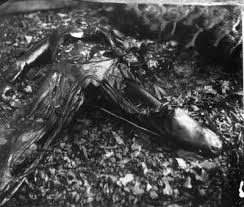After a person has been declared clinically dead and biological death occurs, long after our sentient personality has left this world, certain bodily functions just keep on keepin’ on. Old habits die hard, and in the case of the human body, some habits won’t die just because you do.
1. Brain Activity & Our Five Senses
You may have heard at one point in your life that after death, brain activity continues for a period of time. This is true to some extent, though most of the postmortem brain activity is actually the brain making one last attempt to keep itself alive by using all the oxygen left inside the deceased body. In doing this, brain cells cause irreparable damage to themselves. consciousness can be retained for approximately 15-20 seconds following death- this is true even in the case of people who are decapitated. This short period of consciousness following death is most likely when your “life flashes before your eyes”. Although it is difficult to understand how a person may feel they are literally reliving their entire life in a matter of seconds, it’s very similar to how we perceive time in a dream. Have you ever fallen asleep and had a bizarre dream that felt like it lasted forever, only to realize you’d been sleeping for just a few minutes? That is most likely what is experienced by people who are dying, or having a near death experience. With brain activity continuing after death, our five senses slowly fade after death, as well. The first sense to go is sight, followed by taste, smell, touch and finally, hearing. That means even if you didn’t get a chance to say goodbye before your loved one passed, if you told them something shortly afterwards, they probably still heard it.
2. Post-Mortem Movement and Breathing
Just because your brain has died and all activity has ceased, that doesn’t mean your nervous system has stopped functioning entirely. Often corpses will retain reflex action, causing muscle twitches, spasms, even what appears to be shallow breathing (which is sure to turn anyone’s Wake into an exciting event). These movements are caused when nerves send signals to the spinal cord, but you might want to keep that to yourself and see if you can convince everyone at the Wake that your grandmother is turning into a zombie.
3. Skin
Skin cells do not need constant circulation to survive, which means they’ll outlive you by several days. Unfortunately, you won’t be able to grow and new skin cells, so any wounds you previously have or acquire during death will not heal. That means any tattoos, piercings, plastic surgery, microdermabrasion etc. that you were considering having don postmortem to look good for your last hoorah probably wont look as great as you may have imagined.
4. Hair and Nails Appear to Grow
…they don’t really, but it certainly looks that way. Same as your skin, no new hair or nail tissue will grow. A body begins to lose all its moisture following death. When all that water weight starts dropping off, you get a postmortem face lift. The pulling back and tightening of your skin from lack of moisture gives the appearance of hair and nail growth, when in actuality you are just shriveling up and shrinking.
5. Vocal Chords
When you die, the bacteria in your body that once digested your food begins eating you from the inside out. This causes a tremendous build-up of gasses inside your body which has to escape somehow. There are many ways in which these gasses evacuate the corpse, one of the less disturbing methods being through your windpipe… And yes, that is one of the less disturbing ways. It causes moans, groans, even squeaks to come from the deceased.
6. Pee/Poo/Farts
There is a common misconception that some people urinate when they die. Luckily, we’re here to dispel those kind of rumors; The truth is, almost everyone pees themselves when they die. The urinary sphincter is held shut by a part of your brain, so when your brain stops functioning, your sphincter opens up and everything left in your bladder at the time of death is released. After you die, if you gotta go well… You really gotta go because your brain is no longer able to “hold it”. If it helps ease your mind, you won’t necessarily “pee your pants”. Assuming you live a long life and die a natural death, this postmortem urine could very easily be collected by a catheter. Another misconception is that some people defecate one last time at the moment of death- this is just a flat out lie… Due to the fact that the bacteria in your body that digests food won’t begin eating you until all the food is gone, almost everyone poops for days following their death. Remember when I said there were many more disturbing ways built-up gas can escape a corpse? Pooping is one of them. Excess gasses often expel themselves through the anus, taking with them whatever is in their path… which is usually human waste. More commonly refered to as “poop”. The expulsion of gasses through the anus can also cause lots of postmortem farting. I think the disgusting child in all of us can appreciate the fact that even in death, we can (and will) fart up a storm in the coroner’s office.
7. Death Erections (and Ejaculations)
After all the blood in your system has stopped circulating, it begins to pool. The effects of this are most evident during the 4th stage of decomposition known as “Livor Mortis”, which you can learn all about here on The Post-Mortem Post on Thursday April 9th. All you need to know now is that after death blood pools in the lowest (in relation to the rest of the world) regions of the body. This means if you die standing up or laying face down, one place blood will pool is in the genitalia. When a male’s penis- living or dead fills with blood, it causes an erection. In the days of public hangings, when bodies were not always removed in a prompt and courteous manner, people became very familiar with the phenomenon of “death erections”, sported by many men who were hung to their death. During the 3rd phase of decomposition, Rigor Mortis (come back Wednesday April 8th to learn more) every muscle in the body begins to harden. The hardening causes contraction of the muscles and sometimes all that hardening and contracting can cause a corpse to ejaculate.
8. Coffin Birth
As we all know, pregnancy and childbirth used to be an incredibly dangerous experience for women. In a time before prenatal vitamins, ultrasounds and blood transfusions (with the correct type of blood) it was all too common for a woman to die during some stage of her pregnancy. Unfortunately, in those times, not everyone was able to receive a burial soon after death, or in some cases, ever. Due to this, there were a few rare accounts of women who had given birth, postmortem. These “Coffin Births”, as they became known, were caused by a combination of softening, deceased flesh and a build up of gasses within the cadaver. In some instances, this gas escaped through the vaginal canal of a female corpse, bringing a living, breathing baby out with it. Yes, you guessed it- the expulsion of postmortem gasses through the vaginal canal could also cause corpse queefs.
MYTH: In the late 1800s and early 1900s Optography was all the rage. Used as a plot device in many fictional murder mysteries at the time, it was also utilized in real-life crime solving. After Franz Christian Boll discovered rhodopsin, also known as “visual purple”, a photosensitive pigment in the retina which can be “fixed” similar to a photographic negative, German psychologist William Kuhne set to work researching how this could be helpful in solving crimes.There was a belief that an optogram could capture the last image seen before death on the retina of the deceased. This led investigators to believe they might have a shot at capturing an image of the killer in the eye of their victim. Kuhne did a lot of very mean, sad things to rabbits during his research that we do not condone and we don’t wanna talk about it… So instead we’ll jump to November 16, 1880 when William Kuhne finally got the shot to test this theory on a human eye. Erhard Gustav Reif was executed by guillotine after killing his children in Bruchsal. Immediately following his death, Reif’s eyes were extracted and sent to Kuhne to be analyzed. Kuhne found that on the left eye of Erhard Gustav Reif there was a vague outline of what appeared to be the guillotine blade.

Outline of optograph obtained from subject’s left retina.
This was a huge discovery in forensics… until people began to put two and two together and realized that the position in which Erhard Gustav Reif was placed at the time of his execution would not have made it possible for him to see the blade of the guillotine, not to mention he was blindfolded at the time. Despite the fact that is scientific reasoning to support how this theory would work… it just doesn’t, at least, not now. It is possible optography will be more thoroughly researched and one day, perfected as a method for solving murder.
Check out the NEW BOOK by The Post-Mortem Post’s Head Writer ‘Horrible History: Mass Suicides’ AVAILABLE NOW on Amazon Kindle!
If you enjoyed this article (or didn’t and want to know ways to minimize you postmortem farting and corpse queefs) you may like Burying the Dead is Killing the Planet, and Demystifying the Process of Dying.
Find out more about our upcoming Decomposition Week special.
Follow us on Twitter @PostMortem_post


